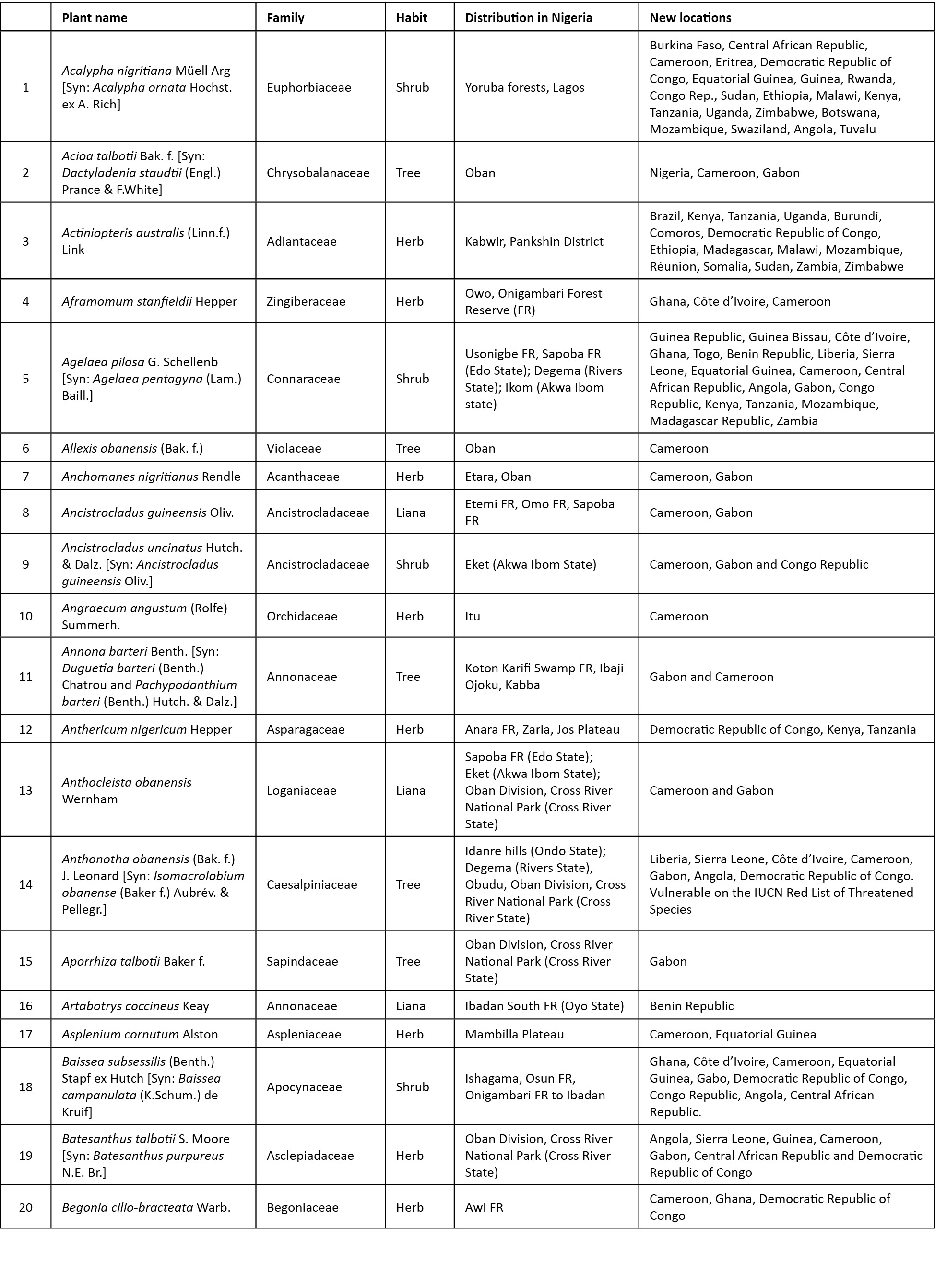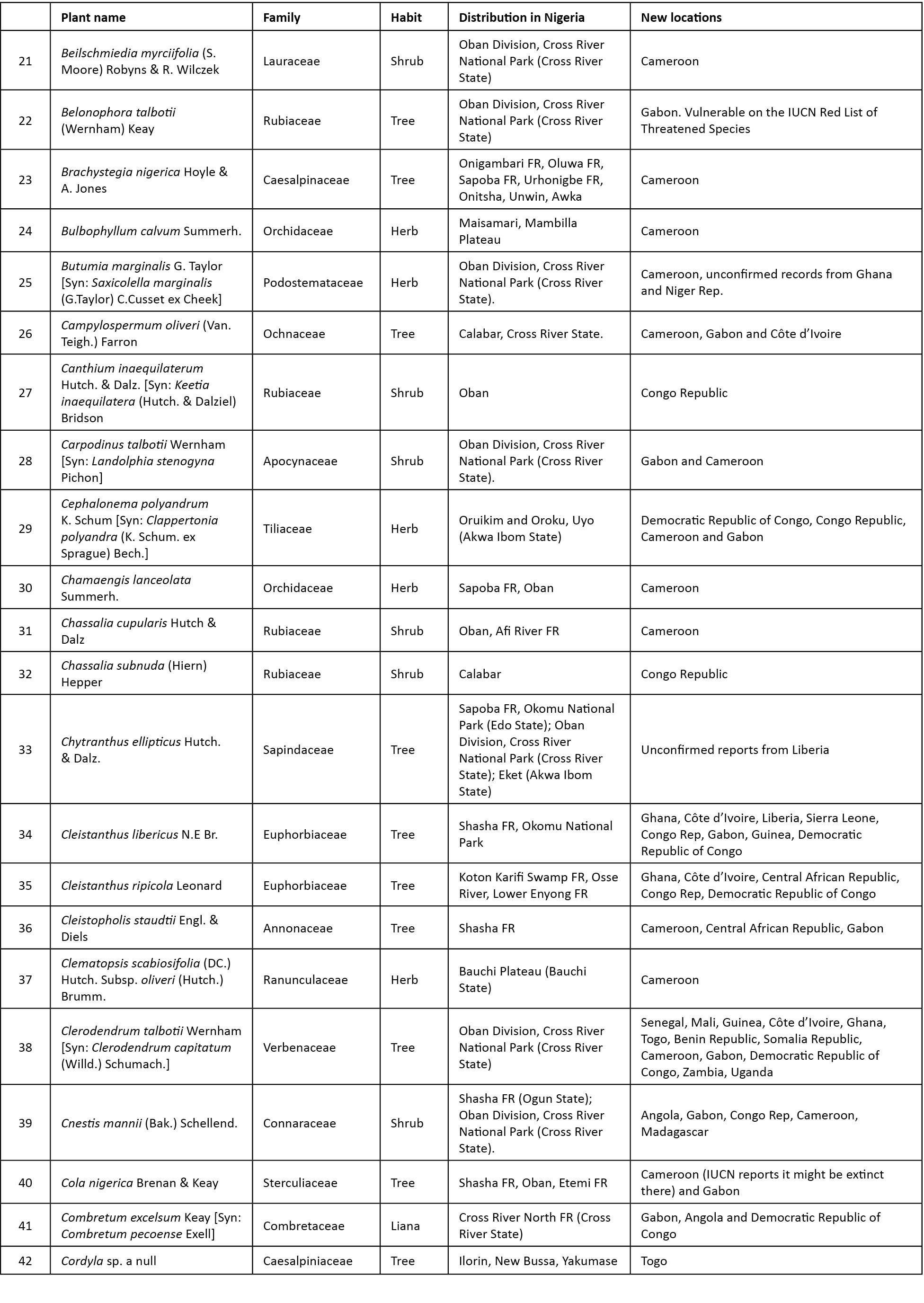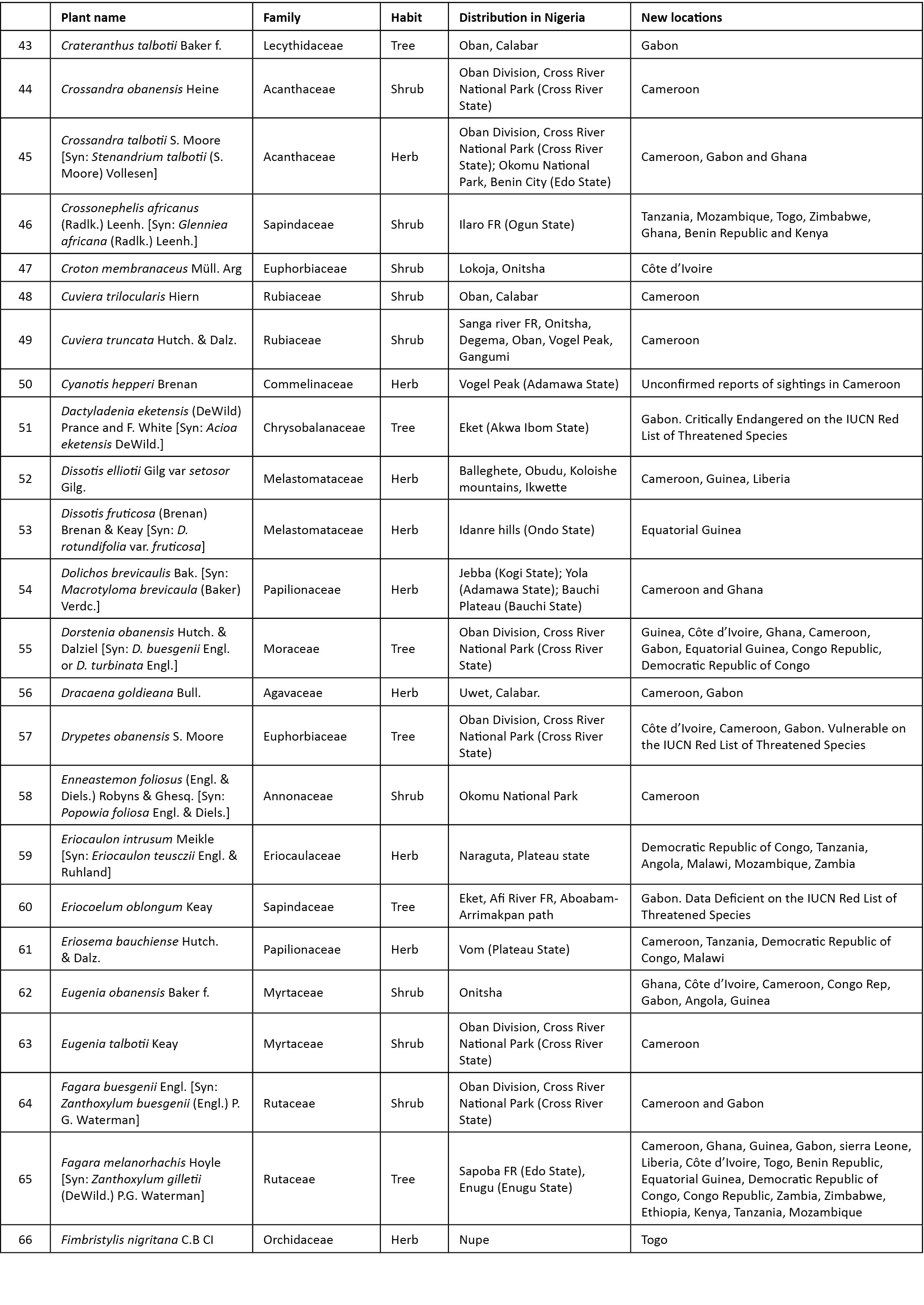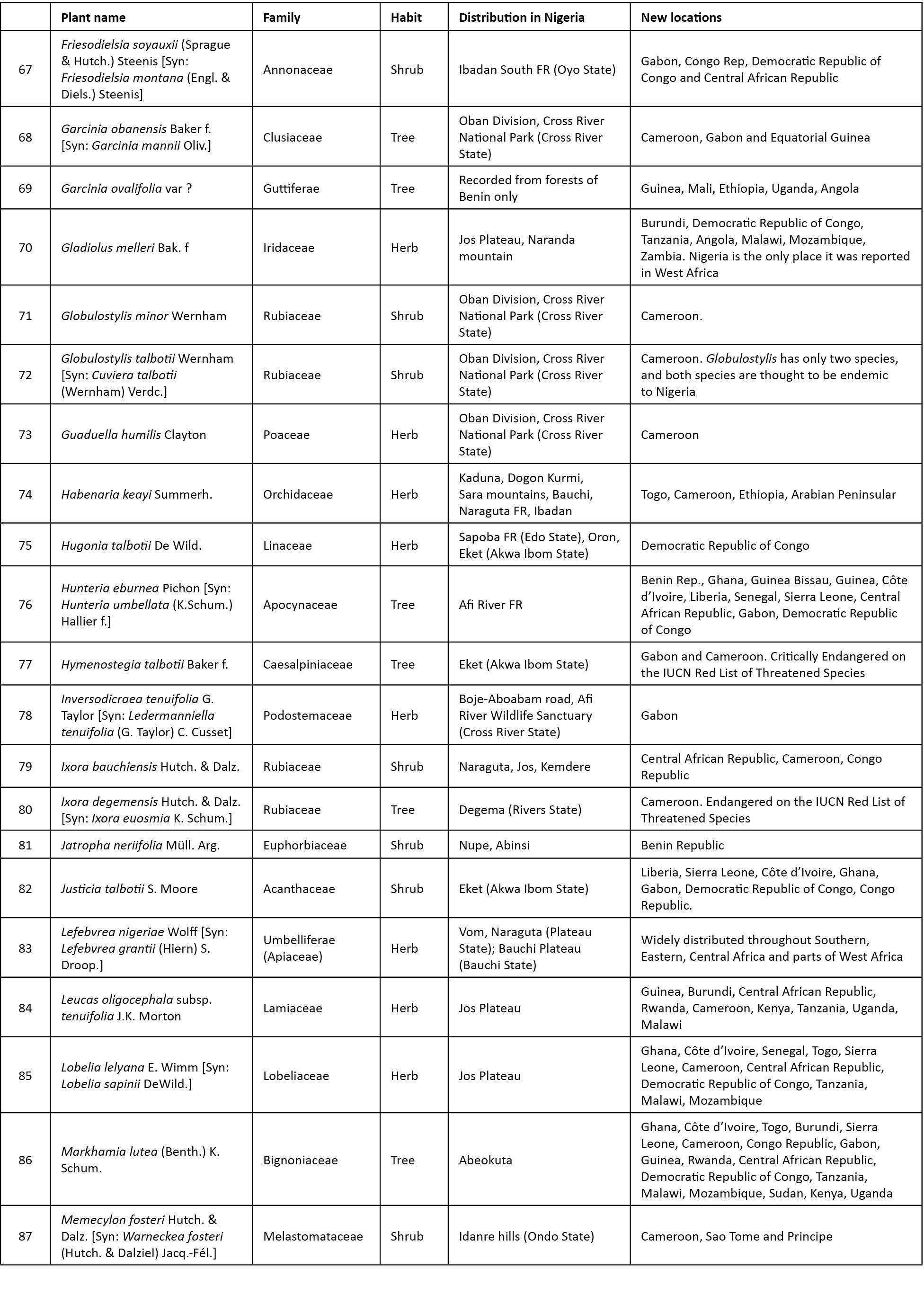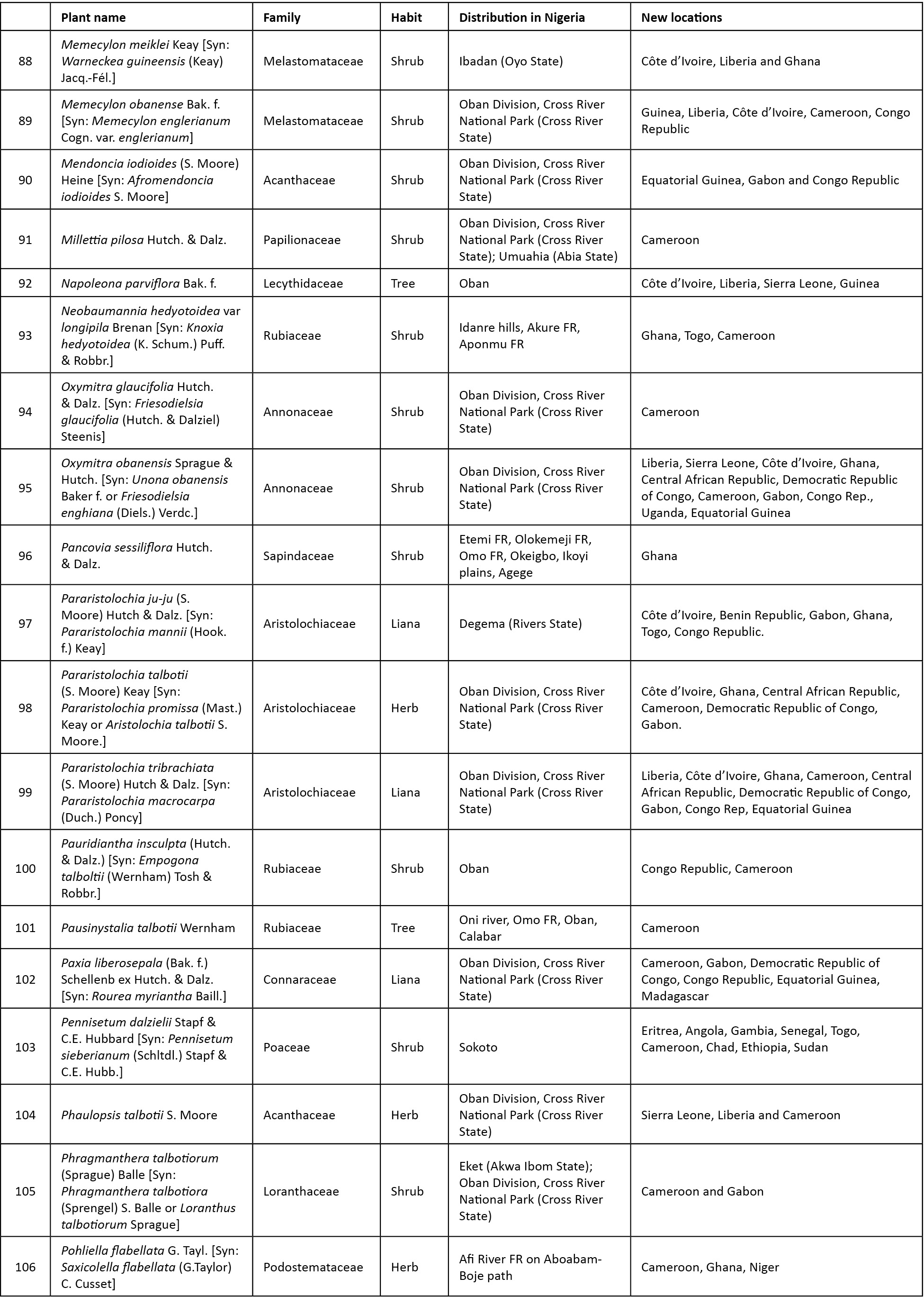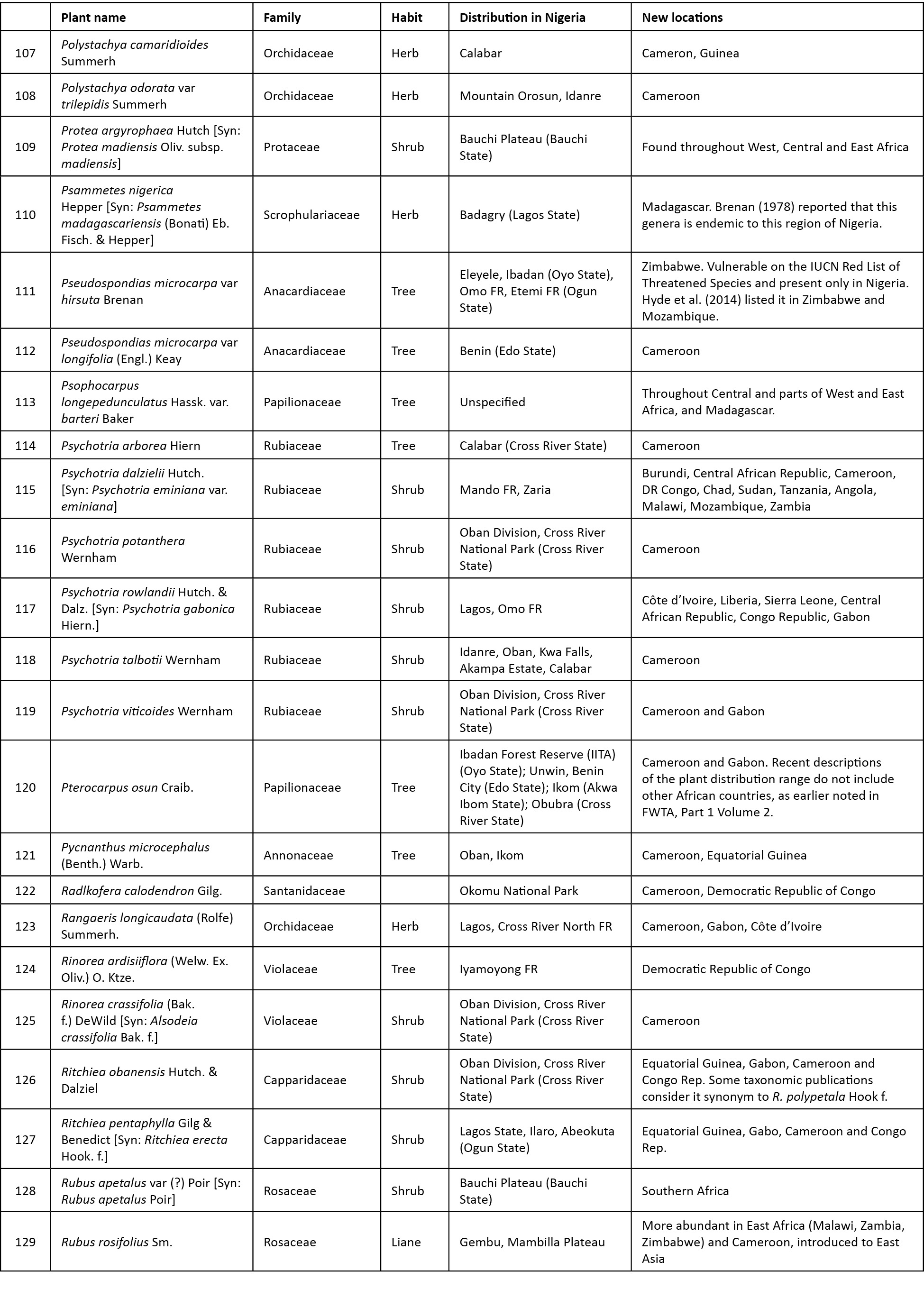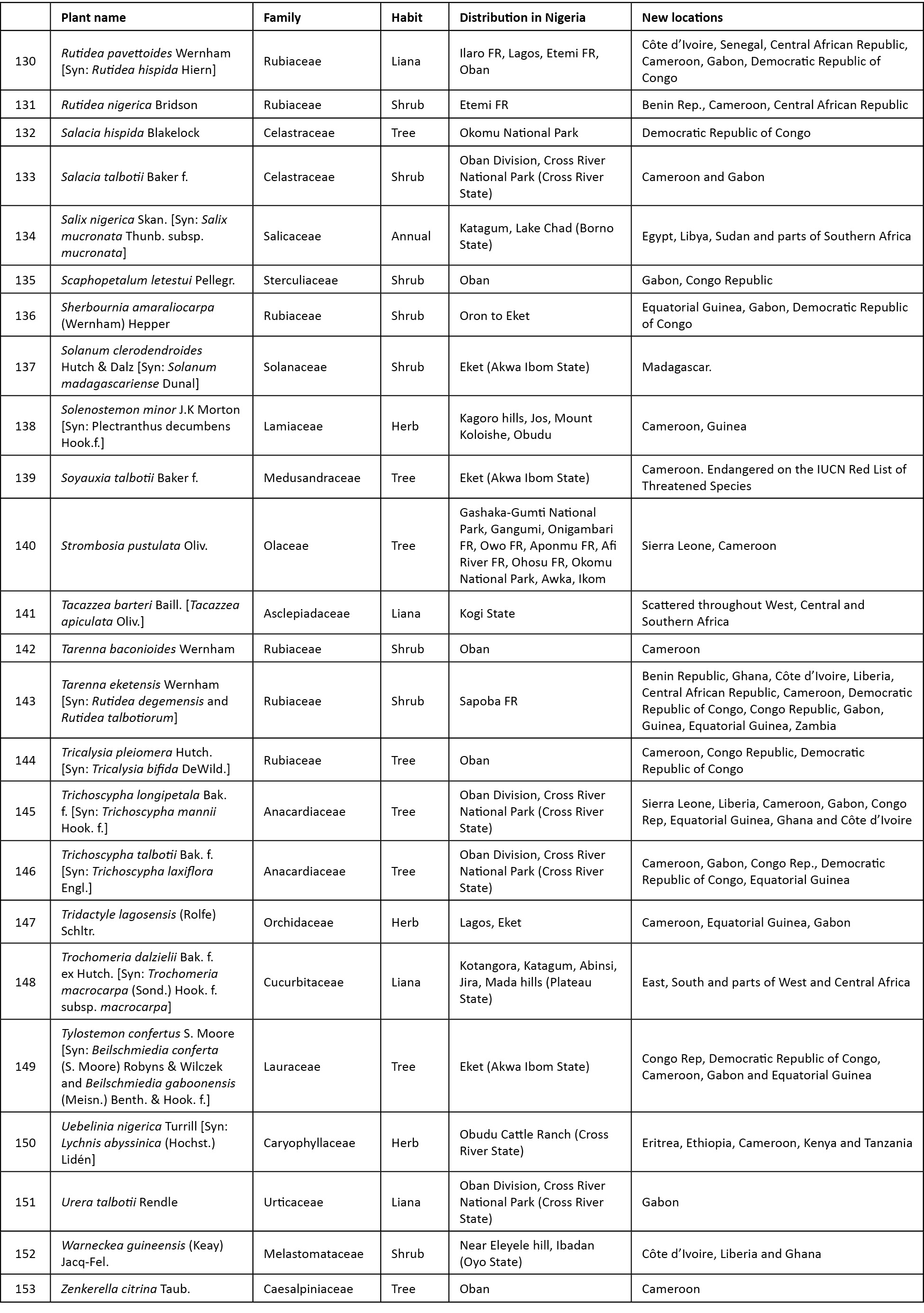Introduction
Naturalists and botanists have recognised the existence of rare and endemic species for centuries. The origin of the word “endemic” as it applied to the distribution of organisms is ascribed to De Candolle (1855). An endemic species is one that is restricted to a particular geographic area; the geographical area can be defined by political boundaries, such as country or department endemics, or by ecological boundaries (Gaston 1991; Beck et al. 2007; Young 2007). The degree of endemism for an area is often cited as a measure of the uniqueness of the flora, and consequently is important for prioritizing sites for conservation (Myers et al. 2000; Brooks et al. 2002; Knapp 2002; Young et al. 2002). It should be noted that the confinement of endemic species to a single habitat renders them extremely vulnerable to environmental change. More than half of the endemic cichlid fishes in Lake Victoria have disappeared since the introduction of Nile perch, a voracious predator, as a game fish by Ugandan officials in the 1920s (Wilson 2010).
Endemism has attracted the attention of biologists and biogeographers since the 19th century (López-Pujol, et al. 2011). Plant and animal endemism is the principal criterion for determination of hotspot status because endemic species are entirely dependent on a single area for their survival, and by virtue of their more restricted ranges, are often the most vulnerable (Myers et al. 2000). These species, confined to highly threatened ecosystems, will almost certainly be the first to be hit by extinction processes, and hence need rapid and effective conservation action (Heywood & Watson 1995). The 25 hotspots cover only 1.4% of the Earth’s land surface, and account for 1,33,149 plant species (44% of all plant species worldwide) and 9,645 vertebrate species (35%) (Myers et al. 2000). More than ever before, conservationists have begun using data on the geography of biodiversity to set priorities for locating protected areas (Brooks et al. 2006).
Many of the world’s hotspots for biodiversity are found in nations with tropical moist forests, but these nations also face profound socio-economic difficulties that cause widespread habitat loss and degradation. Given that endemism and extinction risk are closely coupled (IUCN 2001), actions to minimize global extinction need to focus on patterns in endemism and range-restricted species (Pimm et al. 1995; Myers et al. 2000; Pimm & Brooks 2000). The major issue with endemism is that most species are not scientifically described, and consequently little if anything is known about their ecology or geographical distributions (Pimm & Brooks 2000). Stuart et al. (2010) noted that only 3.9% of 2,82,000 known species have been are studied and evaluated for their conservation status (Stuart et al. 2010).
Rarity is central to tropical forest conservation (Kenfack et al. 2006). The African mainland has between 40,000 and 60,000 plant species (Beentje et al. 1994; Beentje 1996), of which approximately 35,000 are endemic. At least a sixth of the world’s estimated 2,70,000 plant species (Groombridge & Jenkins 2002) are endemic to Africa, while five of the 20 global centres of plant diversity are located in Africa (Barthlott et al. 2005). Yet for most African nations the number of endemic plant species is unknown or poorly estimated, and there is little research or conservation activities concerning them.
Brenan’s 1978 report of plant diversity in Nigeria was based on his analysis of the geographical distribution of all species reported in previous publications (Hepper 1965; Morton 1972; Clayton & Hepper 1974) and the revised editions of Flora of West Tropical Africa (FWTA) (Hutchinson & Dalziel 1958, 1963, 1972). This figure of endemic species was further emphasized in the FEPA (1992) Nigerian biodiversity report. However, since many more species have been discovered after the last edition of the FWTA in 1972, some of the plants that were thought to be endemic to one country have been subsequently recorded from others. This study was carried out to review the current list of endemic species in Nigeria and compile an updated comprehensive list in order to highlight conservation priorities.
Methods
Brenan’s (1978) account of endemism was based on analysis of Flora in Africa and other related studies. In this study identification of Nigerian endemic flora was done primarily via comprehensive secondary data mining of plant records in books, reliable internet resources and herbarium collections, performed between September 2012 and April 2014. The books used were Trees of Nigeria (Keay 1989); Nigerian Trees, volumes 1 and 2 (Keay & Onochie 1964a,b); second and revised edition of Flora of West Tropical Africa (FWTA), volume 1 (parts 1 and 2) (Hutchinson & Dalziel 1958), volume 2 (Hutchinson & Dalziel 1963), and volume 3 (parts 1 and 2) (Hutchinson & Dalziel 1972), and The Useful Plants of West Tropical Africa volumes 1–5 (Burkill 1985, 1994, 1995, 1997, 2000). There exists no nationwide plant survey in Nigeria, thus biogeographical knowledge comes primarily from existing editions of Flora of West Tropical Africa (FWTA). Additional information on the natural distribution of taxa was obtained from the Herbarium (FHI) in Forestry Research Institute of Nigeria (FRIN), Ibadan. References were also made to other publications on checklists of orchids (Segerback 1983), pteridophytes (Alston 1959; Kornas 1983; Nwosu 2002) and bryophytes (O’Shea 2006) in Nigeria. Other vital publications consulted included Keay (1953), Hepper (1965), Bridson (1978), Morton (1972), Clayton & Hepper (1974). Furthermore, reference was also made to the list of Nigerian plants with new names and taxonomic adjustments published by Lowe & Soladoye (1990).
Having compiled the list of endemic plant species in Nigeria, it was screened on updated online Plant Systematics databases such as African Plant Database (2012), IUCN Red list of Threatened Species (IUCN 2013), Rhind (2013), Glenn (2006), Govaerts et al. (2011), IPNI (2012), Angiosperm Phylogeny Group (2009), JSTOR (2013), GBIF (2010), the Plant List (2013) and Tropicos (2014). The plant names, family, growth habit and habitat of the identified endemic plant taxa were noted.
Results
Figure 1 shows a map of Nigeria illustrating the geographical locations of endemic plants listed in Table 1. A total of 91 plant species were identified spread across 44 families, including 23 trees, 22 shrubs, 26 herbs, 14 epiphytes (orchids and bryophytes), three vines and three ferns (Fig. 2). Rubiaceae has the highest number of species (11), followed by Orchidaceae (8), Acanthaceae (7), Papilionaceae and Caesalpiniaceae (5 each), Annonaceae and Malvaceae (4 each; Fig. 3). The endemic flora of Nigeria is spread across 17 states in 55 locations, of which 32 (58.2%) are forest and the rest savannah.
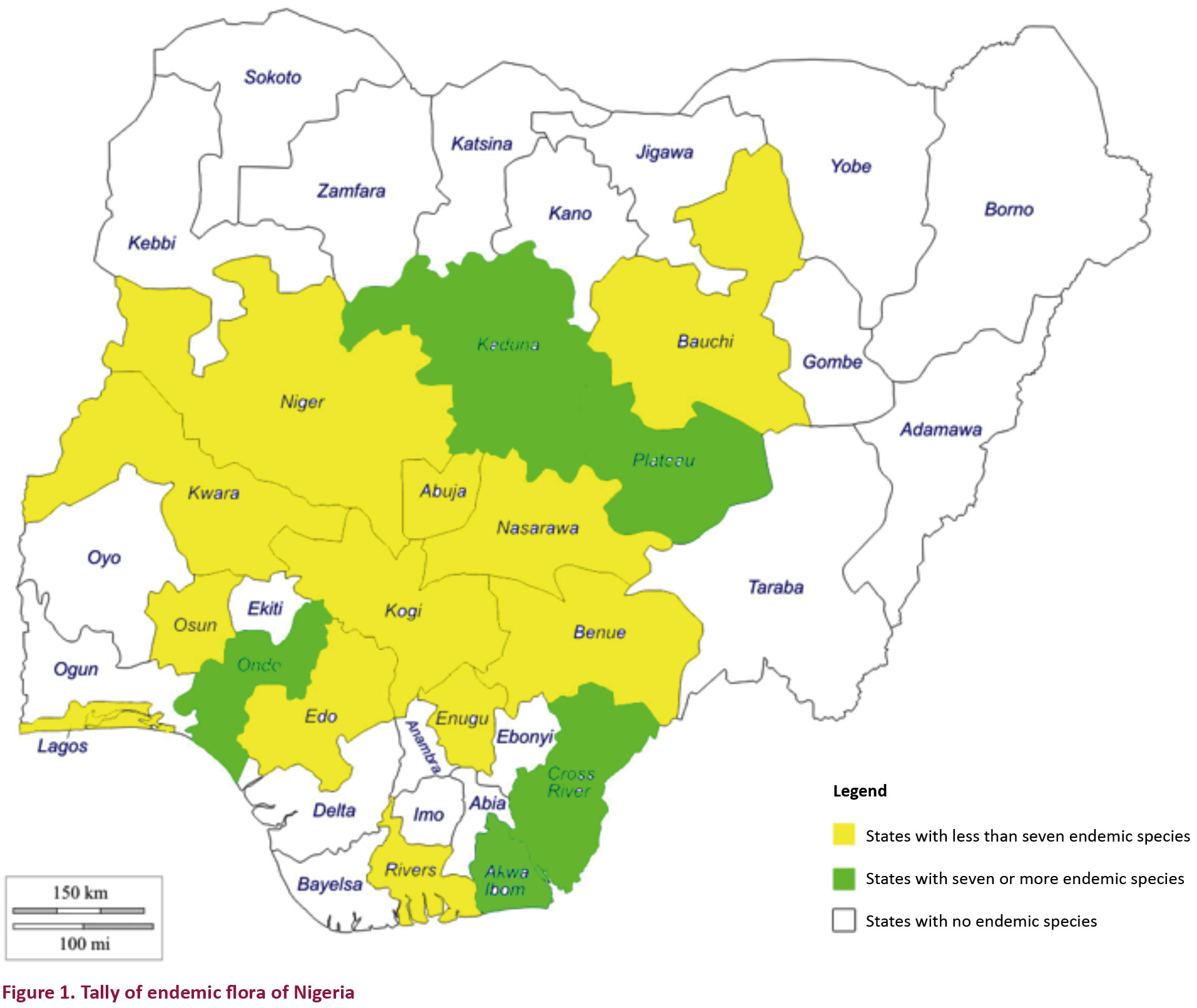
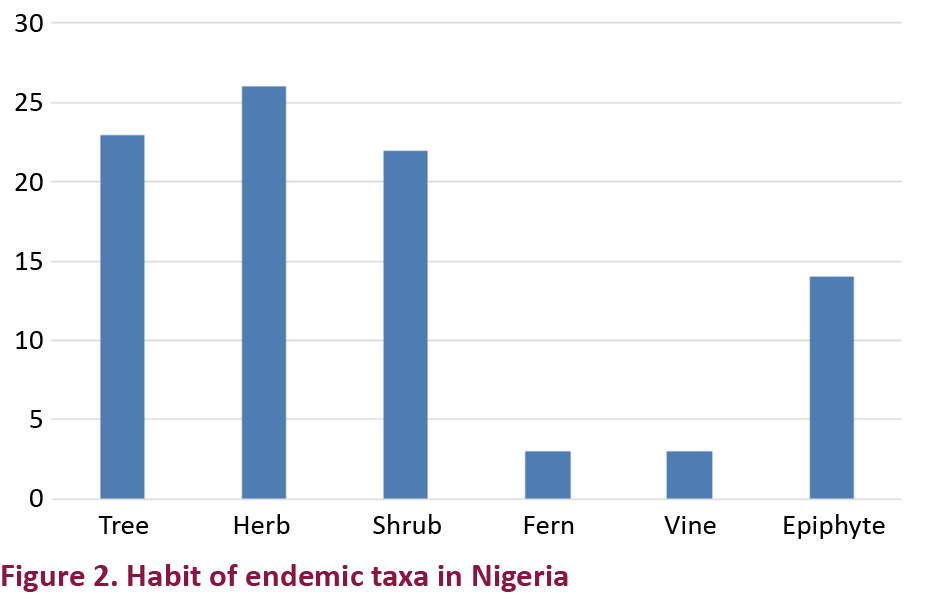
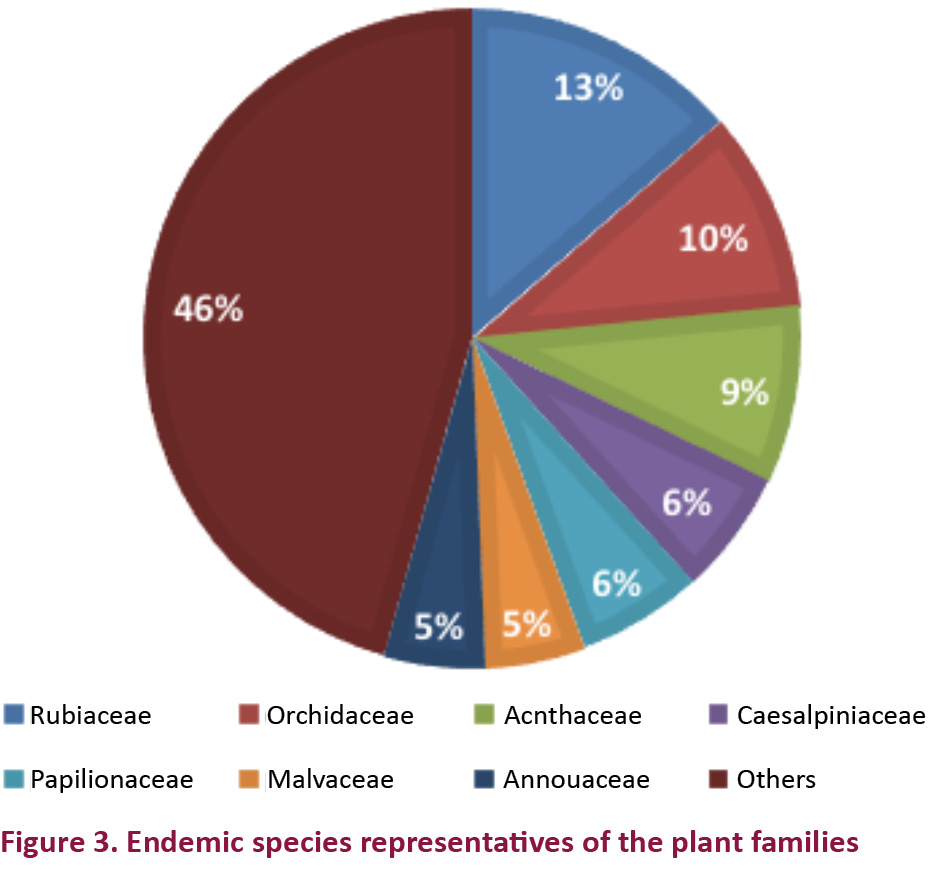
Forty-one endemic species are located in the Oban division of Cross River National Park, while other notable locations include Eket (8 species), Naraguta (4 species), Degema, Idanre Hills, Ukpon River FR, Calabar and Anara FR (3 species each) (Table 1). Nine locations accounting for 57 endemic species are in montane regions, including Idanre Hills, Cross River National Park (Oban division), Bauchi Plateau, Jos Plateau, Gawu hills and Afi Mountain Wildlife Sanctuary. Eight locations accounting for 12 species are located in riparian areas, especially around river Niger. While classifying locations by State boundaries it was noted that Cross River state housed 57 endemic species, followed by Akwa Ibom State (9), Kaduna State (10), Plateau State (8), Ondo State (7), Niger and Kogi States (5 each) and Lagos State (4), while 19 states of the federation had no endemic plant species recorded.
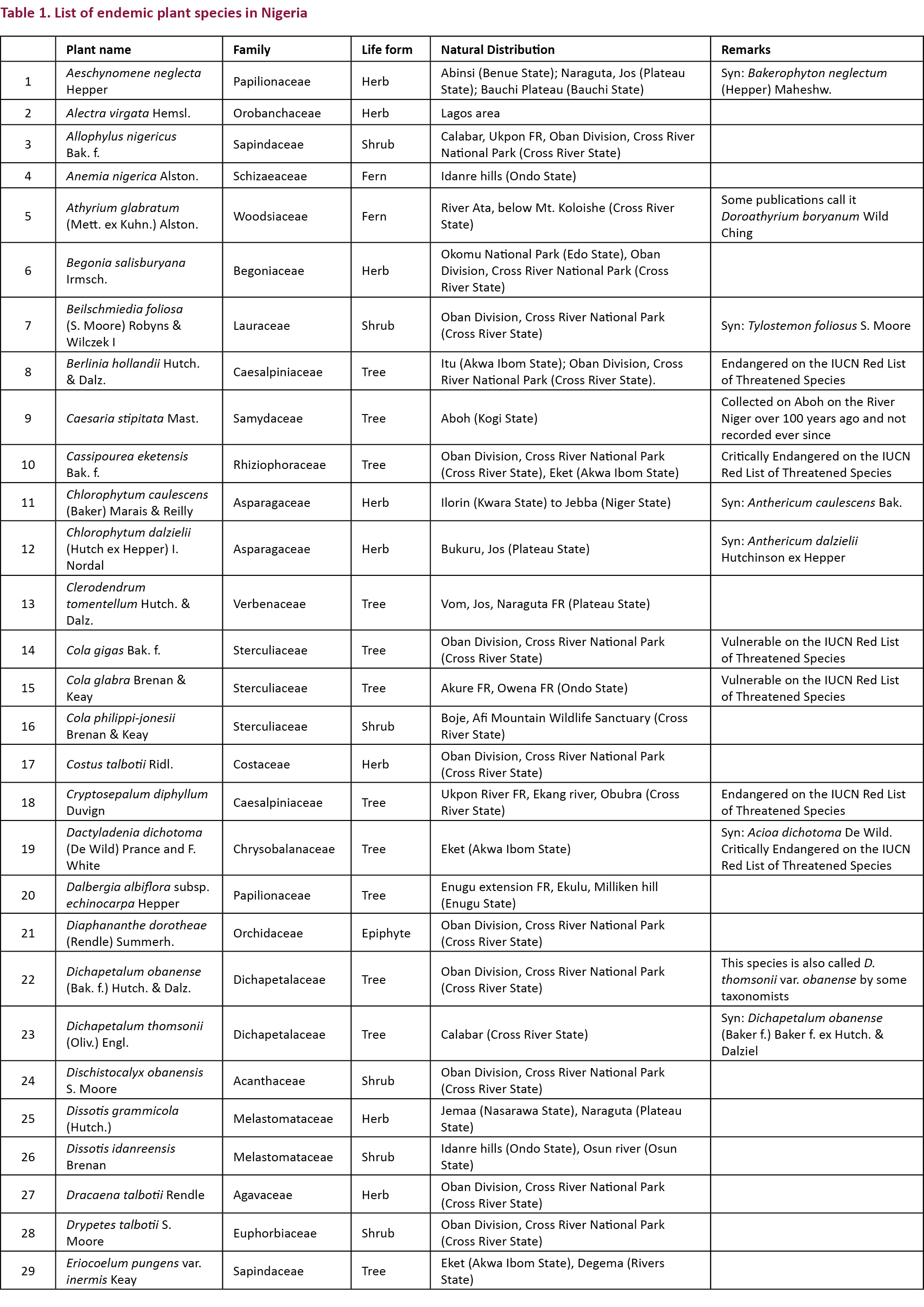
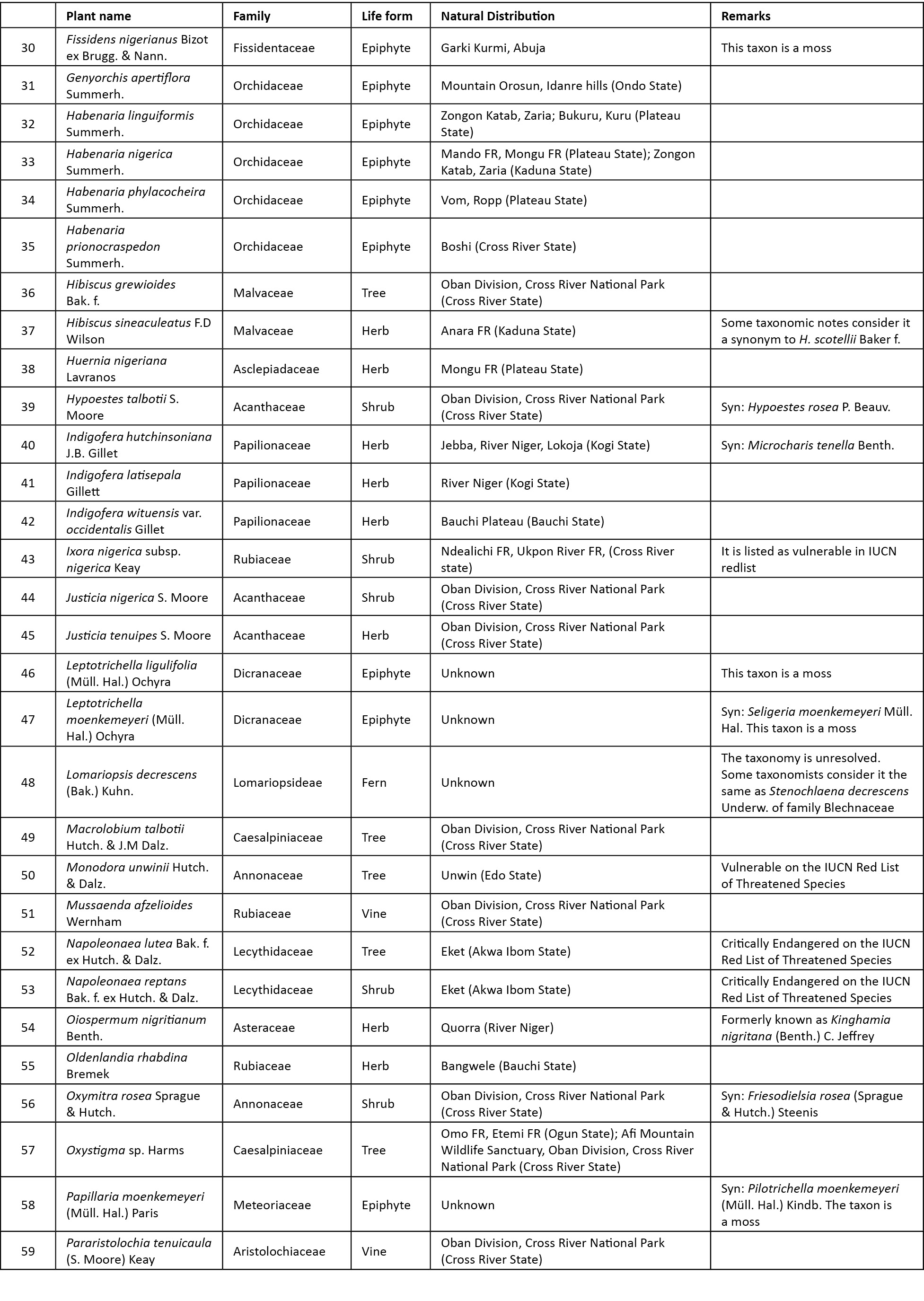
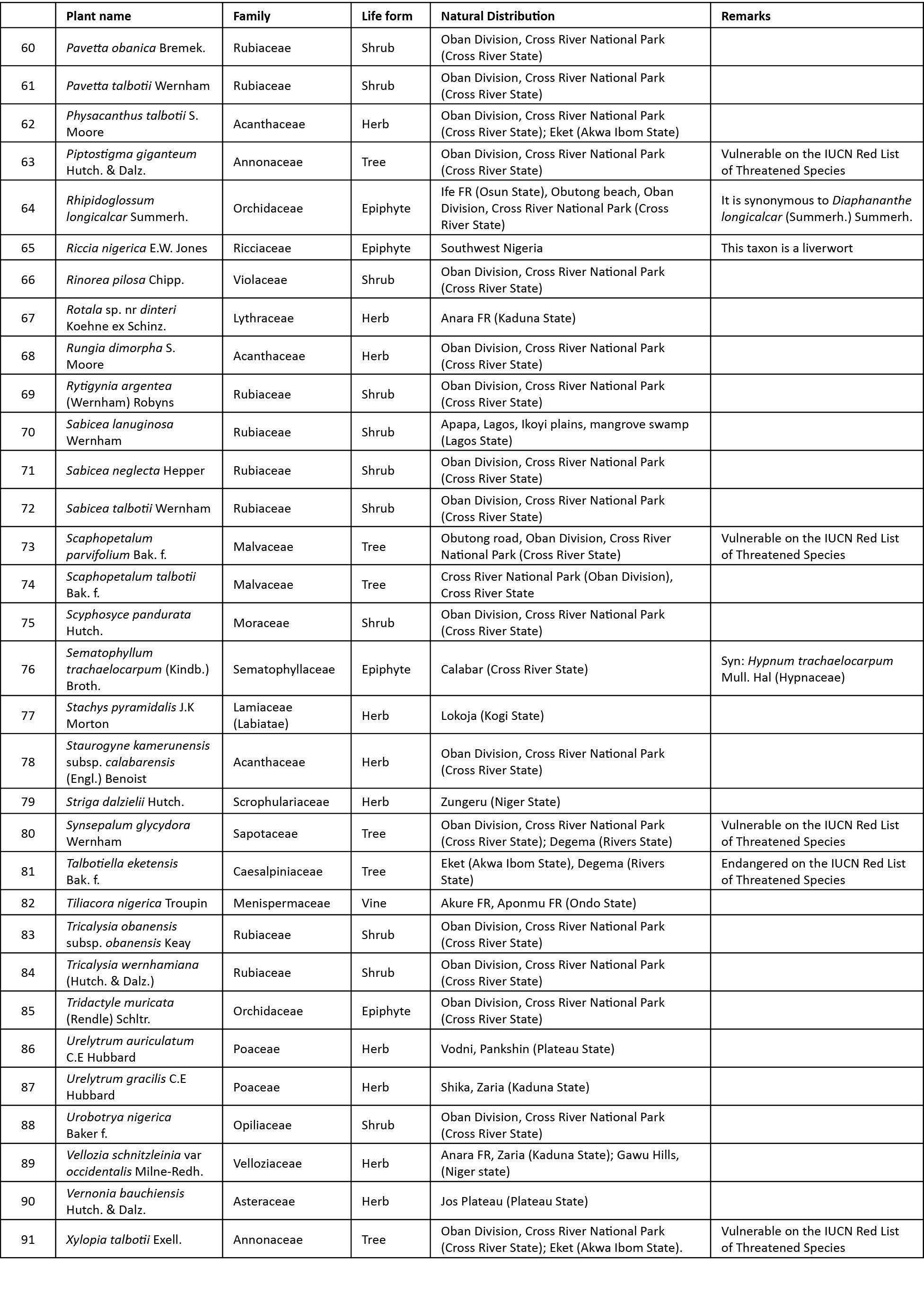
Screening the list of endemic flora in Nigeria in the 2013.2 version of IUCN Red List of Threatened Species revealed that only 15 have been assessed by IUCN, of which eight were classified as “Vulnerable”, three as “Endangered” and the remaining four were “Critically Endangered” (Table 1).
Table 2 shows the list of 153 plants that were once thought to be endemic to Nigeria but have since been found in other African countries, including Cameroon, Gabon, Equatorial Guinea and Democratic Republic of Congo.
Discussion
Changes in plant species endemism in Nigeria
Brenan (1978) gave a detailed account of endemism in tropical Africa. This included 205 endemic species and five endemic genera in Nigeria, 26 in Senegal, 1 in Gambia, 88 in Guinea, 11 in Mali, 74 in Sierra Leone, 59 in Liberia, 41 in Côte d’Ivoire, 43 in Ghana, 20 in Togo, 11 in Benin Republic and 156 in Cameroon. These are in addition to 108 in Sao Tome and Principe, 259 in Somalia Republic, 553 in Ethiopia (and Eritrea), 449 in Tanzania, 378 in Angola and 106 in Kenya among others (Brenan 1978). The West African (Guinean) Forests, of which Nigerian tropical rainforests is part of, is one of the 25 biodiversity hotspots of global significance for conservation priorities (Myers et al. 2000). In addition, the Nigerian rainforest was identified as one of the centres of diversity in Africa (Davis et al. 1994; Beentje et al. 1994; Beentje 1996).
Nigeria was reported to harbour 7,895 plant species from 338 families and 2,215 genera, in addition to 1,489 identified species of microorganisms (Brenan 1978). It was further reported that Nigerian biodiversity comprises 4,903 species of angiosperms, 32 species of gymnosperms, 155 pteridophyte species, 80 bryophyte species, 134 plankton species, 55 bacteria species, 784 algae species, 3,423 fungi species and more than 500 species of viruses (FEPA 1992). Brenan (1978) further stated that 20 plant species had become extinct since 1950, about 431 species were endangered, 45 species were classified as rare, and 20 species were vulnerable. 205 species were endemic, the ninth highest number of endemic species among 42 African countries (Brenan 1978). Out of these 205 endemic species the northern region, with Sudanian affinities, has 39 endemic species, western and central regions have 38, and the eastern region is a host to 128 endemic species (Brenan 1978). In addition, eight moss (bryophytes) species were reported to be endemic to Nigeria (O’Shea 1997). Furthermore, Nigeria is said to rank 11th in Africa in terms of plant diversity (Brenan 1978).
As much as it is important to conserve endemic flora, it is equally important to accurately identify them in order to accord them conservation priorities. However, this study scrutinized the endemic flora in Nigeria and found only 91 to be true endemics in Nigeria, in contrast to 205 earlier reported by Brenan (1978). Likewise, Globulostylis and Psammetes, which were among the reported five endemic genera in Nigeria, have lost their endemic status. A total of 153 species thought to be endemic to Nigeria have been found in other countries (Table 2). Similar findings were reported in India, where 62 earlier reported endemic genera of angiosperms have been found in other countries, while some taxonomic changes to some genera have affected their status (Irwin & Narasimhan 2011). Furthermore, of the 147 earlier reported endemic genera in India (Nayar 1996), Irwin & Narasimhan (2011) concluded that only 49 genera are actually endemic.
This reduction in the number of endemic species in Nigeria may be due to the fact that recent taxonomic and herbarium records show that many have been found in other countries, especially neighbouring Cameroon. Brenan (1978) gave examples of such endemics such as Pennisetum dalzielli, Psychotria dalzielli, Allexis obanensis, Globulostylis talbotii, G. minor and Pohliella flabellata among others, which have been discovered in other countries, thus losing their endemic status in Nigeria (Table 2). In addition, changes in plant adaptability and physiology, gradual spread and increased dispersal capacity, human disturbance, new pests and diseases and new consumers could make some plants cross their natural distribution range to other political boundaries and thus lose their natural endemic status in Nigeria.
As taxonomic records are being improved, some of the endemic species “imperfectly known” in the Flora of West Tropical Africa (FWTA) are being properly described, given binomial names and their geographical distribution determined. For example, Coccinia sp C of FWTA has been properly named as C. adoensis, Cordyla sp. B. as C. pinnata (Lepr. ex A. Rich) Milne-Redhead, Crotalaria sp. A as C. cuspidata Taub, Croton sp. A and sp. B as Croton sylvatica, Diospyros sp. 1 as D. obliquifolia (Hiern ex. Gurke) F. White, Diospyros sp. B as Nigerian Trees (Keay 1989) as D. platanoides Letouzey & F. White, Salacia sp. D as S. cameruunensis Loes, Salacia sp. E as S. lateritia Halle, Salacia sp. J as S. pynaertii De Wild, Placodiscus sp. A as P. opacus Radlk. among many others listed in Lowe & Soladoye (1990). Some of the imperfectly known endemic species in FWTA are in genera such as Psychotria, Ouratea and Eugenia. With the continuous incidence of discovery of new plants globally and as more scientific information is available and shared among countries, updating of documented records of flora is inevitable.
Indeed, there are still many plants yet to be identified in some areas of the country. For instance, it was reported by Chapman & Chapman (2001) that plant species of the mountainous landscape of Mambilla Plateau in Taraba State of Nigeria are endemic and yet to be properly identified. Similarly, it was reported in a short article on Cross River National Park by the Nigerian Park Service that four plant species new to science have been discovered in the Park, which include Tridactyle sp. nov. (Orchidaceae), Uapaca sp. nov. (Euphorbiaceae), Habenaria sp. nov. (Orchidaceae) and Afrocalathea flavida sp. nov. (Marantaceae) (http://crnp.nigeriaparkservice.org/). To confirm this knowledge gap, WWF and IUCN (1994) noted that floral inventory of the Cross River National Park is yet to be completed.
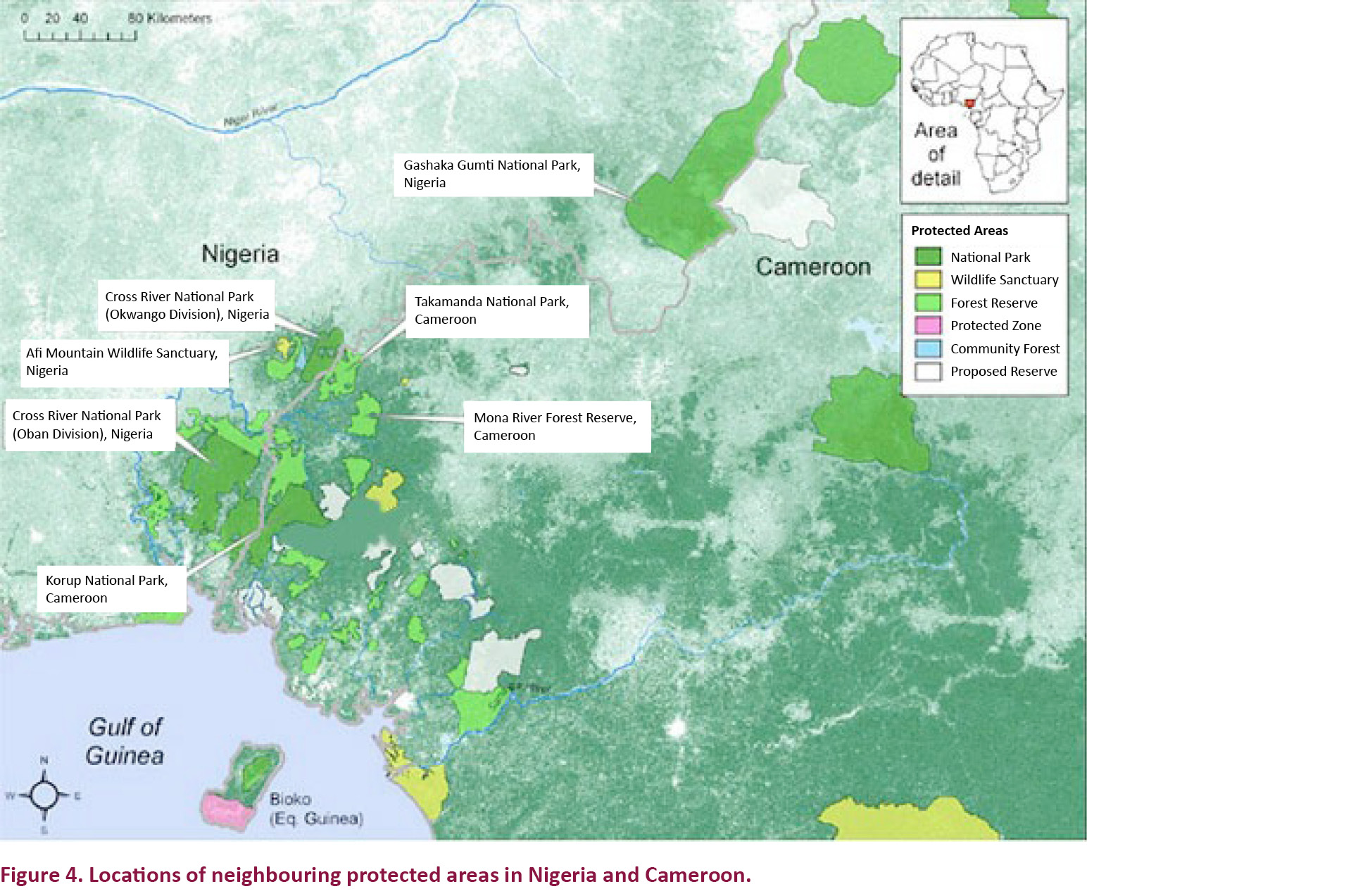
Possible evolutionary trends among endemic species
Rubiaceae was observed to have the highest number of species representatives in the endemic flora of Nigeria, as discovered in this study. Series of plant diversity studies carried out in various parts of Nigeria also show Rubiaceae to be one of the families with the highest number of species representatives (Ojo 2004; Soladoye et al. 2005; Borokini et al. 2010).
Rubiaceae was reported to be among the most diversified and largest of the families in the African rain forest (Robbercht 1996), and the family is identified as the fourth largest plant family globally, with 13,143 species, classified into 611 genera (Davis et al. 2009), more than 40 tribes, and three subfamilies (Goevarts et al. 2006). They occur on all continents (Goevarts et al. 2006), but most taxa are in tropical or subtropical areas (Bremer & Eriksson 2009). Endemism was reported to be generally high in Rubiaceae because many species have restricted distributions. Recording eight out of 11 endemic species of Rubiaceae in Cross River National Park (Oban Division) alone is of scientific interest, all of which are shrubs except for one vine. The same goes for endemic species in families such as Orchidaceae, Acanthaceae, Lecythidaceae and Annonaceae which are found in the same locations and having the same growth habit. It has been reported earlier that endemic species belonging to the same families sharing the same natural habitat must have originated from a single ancestral species (Wilson 2010). Similar situation of discovery of over 500 endemic haplochromine cichlid fish species in Lake Victoria, originating from a single ancestral species was reported by Meyer (1993).
In the same vein, eight endemic species of Orchidaceae were identified in this study. Orchidaceae is the largest plant family on earth, having an estimated 25,000 species, grouped into 850 genera, with over 70% being epiphytes (Gravendeel et al. 2004). Segerback (1983) described 104 species of orchids for Nigeria, but Jayeola (1991) otherwise encountered over 400 species for Nigeria. The African continent harbours around 2,400 orchid species (Madison 1977). The high numbers of representative species of these two families—Rubiaceae and Orchidaceae—indicate a high diversity of these families in Nigerian flora, and therefore, there is the need for thorough studies on the phylogenetic relationship among these species.
Factors that could be responsible for their evolution include development of adaptive features to climate change that occurred thousands of years ago, changes in flowering time, dispersal capacity and some of them may be sun-loving or shade tolerant, with preference for altitudes. Furthermore, it is scientifically accepted that geographical barriers could isolate populations of a single species, leading to allopatric speciation (Templeton 1981; Slatkin 1987; Coyne 1992; Palumbi 1994). The tropical rainforests are a big candidate for any form of speciation—allopatry, parapatry, peripatry, sympatry and ecological. This is because high diversification rate and biogeographic history of tropical environments, abundance of geographical barriers (e.g., mountains, rivers, hills and deep valleys), new niche evolution, species survival in mountainous refugia during the pleistocene age, biotic interactions among species (such as predation, association and competition), spatial heterogeneity, higher metabolic rate, rapid accumulation of genetic incompatibilities and other intrinsic and extrinsic isolating mechanisms could lead to speciation that gave rise to the present species richness and endemism in the present tropical regions (Mittelbach et al. 2007; Schemske et al. 2009; April et al. 2013). Genetic bottlenecks, behavioural isolation and the effects of landscape and metapopulation processes have been demonstrated and reported for several plants and animals, including Lahontan Cutthroat Trout Fish in Nevada and California, United States of America (Neville et al. 2006; Peacock & Dochtermann 2012).
Mountain Biodiversity
The present study shows that nine of the geographical locations of these endemic flora are hills and mountains, harbouring 57 species out of the entire 91 endemic flora, indicating that 62.6% of the endemic species are found in mountainous regions. Literatures have shown that a large fraction of the world’s most precious gene pools are preserved in mountains, while nearly half of the world’s biodiversity hotspots are concentrated on mountains (Spehn et al. 2010), with tropical montane forests noted for their high levels of species endemism and diversity (Gentry 1992, 1993; Kapos et al. 2000; Schmitt et al. 2010). In addition, from Ethiopia to the Cape (South Africa), mountains contain several centres of endemism for birds, mammals, and plants (Fjeldså & Lovett 1997; de Klerk et al. 2002; Goodman & Benstead 2003; Jetz et al. 2004). All these indicate that mountains are centres of biodiversity and endemism, and this should therefore encourage intensive ecological studies on the plant diversity of hills, mountains and inselbergs that spread across Nigeria, for which research information are currently lacking. In addition to this, 32 out of the entire 55 locations are within tropical rainforest ecoregions. The concentration of most of the endemic plants in tropical rainforests in Nigeria is supported by previous findings by Myers et al. (2000), McNeely et al. (1990) and Mittermeier et al. (2000) among others.
Biodiversity of the Nigerian-Cameroon forest complex
The ecological importance and the significance of the biodiversity of the Cameroon-Nigerian forest complex cannot be overemphasised. And recording 66 (72.5%) species out of 91 endemic species in southern Nigeria (Cross River, Akwa Ibom and Rivers states) is another confirmation of not only the global significance of its biodiversity, but also of the species richness of endemic flora in the region. The Korup National Park shares boundaries with Nigeria’s Cross River National Park (Oban Division), while the Okwango division of the Cross River National Park borders the Takamanda Forest Reserve in Cameroon, forming an extensive trans-boundary corridor of biodiversity complex (Fig. 4). This forest ecoregion is a part of the Guineo-Congolian regional centre of endemism (White 1983). Among the taxa that exhibit particularly high levels of species richness and endemism in this trans-boundary ecoregion are primates (Eeley & Lawes 1999; Oates et al. 2004; Sarmiento & Oates 2000; Hilton-Taylor 2000), mammals (AECCG 1991; Happold 1994), amphibians (Lawson 1993; Schiøtz 1999; Kamdem-Toham et al. 2003; Conservation International 2007), birds (Collar & Stuart 1988; Stattersfield et al. 1998), butterflies (Larsen 1997), dragonflies (Vick 1999), fish (Reid 1989), mammals (Burgess et al. 2000), and vascular plants (Cable & Cheek 1998). The biogeographical barriers of the Sanaga River in Cameroon and the Cross River in Nigeria define the mainland boundaries of this ecoregion. These rivers are particularly important geographical barriers for primates, Red-eared Guenon Cercopithecus erythrotis and amphibians, such as Dizangue Reed Frog Hyperolius bopeleti. However, they are significant to global conservation because they are only found within a restricted ecosystem shared between the two countries. In Cameroon’s Korup National Park, 1700 species of vascular plants have been recorded, as many as 5% of which are narrow endemics (Davis et al. 1994). These support the need for a stronger framework for trans-boundary management of biodiversity.
Coexistence of endemic plants and animals
Cross River National Park is the peak of Nigeria’s biodiversity, being the largest tract of the remaining and surviving primary rainforest in Nigeria. About 78% of primate diversity finds home in the protected areas; while it harbours another 30 species of non-primate mammals, including the African Forest Elephant Loxodonta cyclotis, Hippopotamus Hippopotamus amphibious, Forest Buffalo Syncerus cafer nanu, Giant Otter Shrew Potomagale veloxl (Stuart et al. 1990). Over 30% of Nigeria’s 860-bird species are found in the Park, including the endangered Red-headed Rock Picathartes oreas, the rare Green Ibis Bostrychia olivacea, the Violet-backed Flycatcher Hyloita violacea, and the Black Guinea Gowl Agalacea niger, Bannerman’s Weaver, White-throated Babbler, Bat Hawk, Cassin’s Hawk-eagle, Grey-throated Rail, Olive Long-tailed Cuckoo, Bare-cheeked Trogon, Lyre-tailed Honeyguide, Green-backed Bulbul, Grey-throated Flycatcher and Rachel’s Malimbe (Manu & Imong 2006). Eniang & Ijeomah (2011) reported 56 species of snake in the Oban division while 28 snake species were reported for the Okwango division (Eniang et al. 2002) of the Cross River National Park. Larsen (1997) estimated about 950 butterfly species in the Oban division, of which the Cross River National Park officials reported that two are endemic and another two—Tetrahanis okwangwo and T. oboti—are new to science. Furthermore, the Park officials reported that two new frog species were identified, namely Didynamipus sjooesteati and Nyctibates corrugatus, which are new records for Nigeria. The floral diversity of the National Park was reported to be 1,568 species from 523 genera in 98 families. These include 1,303 flowering plants, 141 lichens and 56 moss species.
These information strongly support high mutual existence of endemic flora and fauna; and agrees with earlier reports of association of high floral diversity with high faunal diversity by Siemann et al. (1998), Knops et al. (1999) and Haddad et al. (2001) among others. Species endemism richness, as described by Kier et al. (2009) is the mutual coexistence of endemic flora and fauna in the same geographical area; this was observed in Hawaiian Islands where over 10,000 known endemic insects, 100 endemic birds and about 1,000 endemic flowering plants were reported (Wagner et al. 1990, 2005; Wilson 2010). Similar ecological coexistence was found in the Ash Meadows National Wildlife Refuge in Mojave Desert where about 26 endemic plants and animals (including fishes and insects) were found (U.S. Fish and Wildlife Service 1990) and the east slopes of the Andes Mountains in Peru and Bolivia (Beck et al. 2007). Consequently, areas with the highest percentage of the world’s biodiversity have been proven to harbour a high density of humans with rich cultural diversity (Balmford et al. 2001; Brooks et al. 2002).
Threats to the endemic species
These results present some troubling news with respect to the reported hotspots of this Nigerian endemic flora. For instance, some endemic plants noted to be located in Lagos and Calabar have been completely overtaken by urbanization. Several forest reserves in Nigeria are being de-reserved and concessions given to timber companies for logging, and replacing them with monocultural plantations of exotic trees such as Tectona grandis, Gmelina arborea and Eucalyptus camaldulensis. Furthermore, the indigenous people around around these forest reserves clear significant sections for farming, as well as hunting for wild animals. The presence of those endemic species in those locations and their population status should be investigated. Eket is a big town in Akwa Ibom State in the southern region of Nigeria, housing eight endemic plants in addition to high biodiversity in the region; but is plagued by problems such as oil spillage and gas flaring from commercial oil exploration and acid rain (Nduka et al. 2008; IUCN 2013). These threats have been identified as a major threat to the endemic plants, some of which are already assessed by the IUCN Red List of Threatened species (IUCN 2013).
Collins (1990) and Mittermeier et al. (2000) reported that the West African Guinean forest is the worst damaged of the 25 global hotspots which, due to logging and clearance, have destroyed at least 85% of the rainforests. All these probably support the report that 20 plants are extinct in Nigeria (FEPA 1992). Worse still, a recent survey conducted on the plant collections of all botanic gardens in Nigeria shows that none of these endemic species is being conserved ex situ, as a back-up to these endemics in their natural habitats (see BGCI Garden Search Database for Nigerian botanic gardens <http://www.bgci.org/garden_search.php>). In addition, database search on JSTOR and ISI Web of Science produced very few published research works on any of the endemic plants, indicating a very wide research and knowledge gap on these endemic species, let alone their conservation in Nigeria. For example, in order to ensure effective conservation of threatened species, population viability analysis (PVA) should be conducted to predict their survial in the future.
Therefore, there is the need for intensive conservation of the remaining endemic flora in Nigeria. It is important to note that since timber resources in free public lands have been exhausted in Nigeria, pressure is on timber resources in protected areas, through illegal logging and indiscriminate allocation of forest concessions and de-reservation of forest reserves and other in situ conservation sites. It is safe to say that in situ conservation sites in Nigeria have been heavily disturbed, though efforts are being increased to protect the remaining tracts, especially in Southern Nigeria. Ecological restoration, through re-vegetation of disturbed areas should be done, using indigenous tree species. Community Forestry should be adopted and introduced in the forest reserves and national parks, as a way of combating illegal activities and enhancing participatory forest management. In addition, existing policies governing the management of these protected areas need to be critically reviewed so as to increase transparency in decision making and reducing corruption. Intensive taxonomic and phylogenetic studies, vegetation surveys and biogeographical research should be conducted on the Nigerian flora; in situ conservation efforts have to be supported by adequate ex situ conservation measures.
References
AECCG (1991). The African elephant conservation review. Unpublished Report of the African Elephant Conservation Coordinating Group, Oxford, UK 58pp.
African Plants Database (2012). African Plants Database (version 3.4.0). Conservatoire et Jardin botaniques de la Ville de Genève and South African National Biodiversity Institute, Pretoria, <http://www.ville–ge.ch/musinfo/bd/cjb/africa/> Assessed August 2014.
Alston, A.H.G. (1959). The Ferns and Fern-allies of West Tropical Africa. Being a supplement to the 2nd Edition of the Flora of West Tropical Africa. Crown Agents for Oversea Governments and Administration (London), 89pp.
APG (2009). The Botanical Classification of Angiospermae. Angiospermae Phylogeny Group (APG). <http://www.f-lohmueller.de/botany/apg/apg_iii.htm> Accessed 26 August 2013.
April, J., R.H. Hanner, R.L. Mayden & L. Bernatchez (2013). Metabolic rate and climatic fluctuations shape continental wide pattern of genetic divergence and biodiversity in fishes. PLoS ONE 8 (7): e70296; http://dx.doi.org/10.1371/journal.pone.0070296
Balmford, A., J.L. Moore, T. Brooks, N. Burgress, L.A. Hansen, P. Williams & C. Rahbek (2001). Conservation conflicts across Africa. Science 291: 2616–2619; http://dx.doi.org/10.1126/science.291.5513.2616
Barthlott, W., J. Mutke, M.D. Rafiqpoor, G. Kier & H. Kreft (2005). Global centres of vascular plant diversity. Nova Acta Leopoldina 92 (342): 61–83
Beck, S.G., P.A. Hernandez, P.M. Jørgensen, L. Paniagua, M.E. Timaná & B.E. Young (2007). Vascular plants. Pp. 18–34, In: Young, B.E. (ed.). Endemic Species Distributions on The East Slope of The Andes in Peru and Bolivia. NatureServe, Arlington, Virginia, USA, 628pp.
Beentje, H.J. (1996). Centres of plant diversity in Africa, pp. 101–109. In: van der Maesen, L.J.G., van der Burgt, X.M. & J.M. van Medenbach de Rooy (eds.). The Biodiversity of African Plants. Proceedings XIVth AETFAT congress, 22–27 August 1994, Wageningen, The Netherlands. Kluwer Academic Publishers, Dordrecht, XV+861pp.
Beentje, H., B. Adams, S.D. Davis & A.C. Hamilton (1994). Regional overview: Africa, pp. 101–48. In: Davis, S.D., V.H. Heywood & A.C. Hamilton (eds.). Centres of Plant Diversity: A Guide and Strategy for their Conservation, Volume 1: Europe, Africa, South West Asia and the Middle East. IUCN - The World Conservation Union, Cambridge UK, 368pp.
Borokini, T.I., A.U. Okere, A.O. Giwa, B.O. Daramola & W.T. Odofin (2010). Biodiversity and Conservation of Plant Genetic Resources in Field Genebank of the National Centre for Genetic Resources and Biotechnology, Ibadan, Nigeria. International Journal of Biodiversity and Conservation 2(3): 37–50.
Bremer, B. & T. Eriksson (2009). Time tree of Rubiaceae: Phylogeny and dating the family, subfamilies and tribes. International Journal of Plant Science 170(6): 766–793; http://dx.doi.org/10.1086/599077
Brenan J.P.M. (1978). Some Aspects of the Phytogeography of Tropical Africa. Annals of the Missouri Botanical Garden 65(2): 437–478; http://dx.doi.org/10.2307/2398859
Bridson, D.M. (1978). A short revision of Rutidea (Rubiaceae). Kew Bulletin 33(2): 243–278; http://dx.doi.org/10.2307/4109578
Brooks, T.M., R.A. Mittermeier, C.G. Mittermeier, G.A.B. Da Fonseca, A.B. Rylands, W.R. Konstant, P. Flick, J.D. Pilgrim, S. Oldfield, G. Magin & C. Hilton-Taylor (2002). Habitat loss and extinction in the hotspots of biodiversity. Conservation Biology 16: 909–923; http://dx.doi.org/10.1046/j.1523-1739.2002.00530.x
Brooks, T. M., R.A. Mittermeier, G.A.B. Da Fonseca, J. Gerlach, M. Hoffmann, J.F. Lamoreux, C.G. Mittermeier, J.D. Pilgrim & A.S.L. Rodrigues (2006). Global Biodiversity Conservation Priorities. Science 313: 58–61; http://dx.doi.org/10.1126/science.1127609
Burgess, N.D., H. De Klerk, J. Fjeldså, T. Crowe & C. Rahbek (2000). A preliminary assessment of congruence between biodiversity patterns in Afrotropical forest birds and forest mammals. Ostrich 71: 286–290; http://dx.doi.org/10.1080/00306525.2000.9639929
Burkill, H.M. (1985). The Useful Plants of West Tropical Africa. 2nd Edition. Volume 1, Families A–D. Royal Botanic Gardens, Kew, United Kingdom, 960pp.
Burkill, H.M. (1994). The Useful Plants of West Tropical Africa. 2nd Edition. Volume 2, Families E–I. Royal Botanic Gardens, Kew, United Kingdom, 636pp.
Burkill, H.M. (1995). The Useful Plants of West Tropical Africa. 2nd Edition. Volume 3, Families J–L. Royal Botanic Gardens, Kew, United Kingdom, 857pp.
Burkill, H.M. (1997). The Useful Plants of West Tropical Africa. 2nd Edition. Volume 4, Families M–R. Royal Botanic Gardens, Kew, United Kingdom, 969pp.
Burkill, H.M. (2000). The Useful Plants of West Tropical Africa. 2nd Edition. Volume 5, Families S–Z, addenda. Royal Botanic Gardens, Kew, United Kingdom, 686pp.
Cable, S. & M. Cheek (1998). The Plants of Mount Cameroon: A Conservation Checklist. Royal Botanic Gardens, Kew.
Chapman, J.D. & H.M. Chapman (2001). The Forests of Taraba and Adamawa States, Nigeria. An Ecological Account and Plant Species Checklist. University of Canterbury, Christchurch, New Zealand.
Clayton, W.D. & F.N. Hepper (1974). Computer-aided chronology of West African grasses. Kew Bulletin 29: 219–233.
Collar, N.J. & S.N. Stuart (1988). Key Forests for Threatened Birds in Africa. ICBP, Cambridge.
Collins, M. (ed.) (1990). The Last Rain Forests. A World Conservation Atlas. Oxford University Press, New York, 200pp.
Conservation International (2007). “Biodiversity Hotspots: Guinean Forests of West Africa.” <http://www.biodiversityhotspots.org/xp/hotspots/west_africa/Pages/biodiversity.aspx> Assessed June 12, 2008.
Coyne, J.A. (1992). Genetics and speciation. Nature 355: 511–515; http://dx.doi.org/10.1038/355511a0
Davis, S.D., V.H. Heywood & A.C. Hamilton (eds.) (1994). Centres of Plant Diversity. A Guide and Strategy for their Conservation. Volume 1. Europe, Africa, South West Asia and the Middle East. World Wildlife Fund (WWF) and the World Conservation Union (IUCN), Cambridge UK, 368pp.
Davis, A.P., R. Govaerts, D.M. Bridson, M. Ruhsam, J. Moat & N.A. Brummitt (2009). A Global Assessment of Distribution, Diversity, Endemism, and Taxonomic Effort in the Rubiaceae. Annals of the Missouri Botanical Garden 96(1): 68–78; http://dx.doi.org/10.3417/2006205
De Candolle, A.P. (1855). Geographie Botanique Raisonnee: ou, Exposition des faits principaux et des lois concernant la distribution géographique des plantes de l’époque actuelle. Vols. 1 & 2. V. Masson, Paris. 656pp.
De Klerk, H.M., T.M. Crowe, J. Fjeldsa & N.D. Burgess (2002). Biogeographical patterns of endemic terrestrial Afrotropical birds. Diversity Distributions 8: 147–162; http://dx.doi.org/10.1046/j.1472-4642.2002.00142.x
Eeley, H.A.C. & M.J. Lawes (1999). Large-scale patterns of species richness and species range size in anthropoid primates, pp. 191–219. In: Fleagle, J.G., C. Janson & K.E. Reed (eds.). Primate Communities. Cambridge University Press, Cambridge, 339pp.
Eniang, E.A. & H.M. Ijeomah (2011). Diversity of Ophidian species in Oban Division of the Cross River National Park, Nigeria. Production Agriculture and Technology Journal 7(1): 188–201.
Eniang E.A., I.J. Ekpo, G.C. Akani & L. Luiselli (2002). On the composition of the snake fauna of Uyo, a recently deforested area in Nigeria. Herpetozoa 14 (3/4): 143–147.
FEPA (1992). Biological Diversity in Nigeria: A Country Study 1991–1992. Federal Environmental Protection Agency, Lagos, 192pp.
Fjeldsa, J. & J.C. Lovett (1997). Geographical patterns of old and young species in African forest biota: the significance of specific montane areas as evolutionary centres. Biodiversity Conservation 6(3): 325–346; http://dx.doi.org/10.1023/A:1018356506390
Gaston, K.J. (1991). How large is a species’ geographical range? Oikos 61: 329–335.
Gentry, A.H. (1992). Tropical Forest Biodiversity: distributional patterns and their conservation significance. Journal of Oikos 63: 19–28; http://dx.doi.org/10.2307/3545512
Gentry, A.H. (1993). Patterns of diversity and floristic composition in neotropical montane forests, pp. 103–126. In: Churchill, S.P., H. Balslev, E. Forero & J.L. Luteyn (eds.). Biodiversity and Conservation of Neotropical Montane Forests. Proceedings of Neotropical Montane Ecosystem Symposium, New York, 432pp.
Glenn, C.R. (2006). Earth’s Endangered Creatures (online). <http://earthsendangered.com> Accessed 10–25 January, 2013.
GBIF (2010). Global Biodiversity Information Facility version 1.3.1. <http://www.gbif.org> Accessed 26 August 2013.
Goodman, S.M. & J.P. Benstead (eds.) (2003). The Natural History of Madagascar. University of Chicago Press, Chicago, 1728pp.
Gravendeel, B., A. Smithson, F.J.W. Slik & A. Schuiteman (2004). Epiphytism and pollinator specialization: drivers for orchid diversity? Philosophical Transactions of the Royal Society B: Biological Sciences 359: 1523–1535; http://dx.doi.org/10.1098/rstb.2004.1529
Groombridge, B. & M.D. Jenkins (2002). World Atlas of Biodiversity. Prepared by the UNEP World Conservation Monitoring Centre. University of California Press, Berkeley, USA, 352pp.
Govaerts, R., M. Ruhsam, L. Andersson, E. Robbrecht, D. Bridson, A. Davis, I. Schanzer & B. Sonkâ (2011). World Checklist of Rubiaceae. The Board of Trustees of the Royal Botanic Gardens, Kew. Published on the Internet; <http://www.kew.org/wcsp/rubiaceae> Accessed 21 February 2013.
Haddad, N.M., D. Tilman, J. Haarstad & J.M.H. Knops (2001). Contrasting effects of plant richness and composition on insect communities: a field experiment. American Naturalist 158: 17–35.
Happold, D.C.D. (1994). Mammals of the Guinea-Congo rain forest, pp. 243–284. In. Alexander, I.J., M.D. Swaine & R. Watling (eds.). Essays on the ecology of the Guinea-Congo rain forest. Proceedings of the Royal Society of Edinburgh Series B, Biological Sciences 104: f1–f6.
Hepper, F.N. (1965). Preliminary account of the phytogeographical affinities of the Flora of West Tropical Africa. Webbia 19: 593–617.
Heywood, V.H. & R.T. Watson (1995). Global Biodiversity Assessment. Cambridge University Press, New York, 1140pp.
Hilton-Taylor, C. (2000). 2000 IUCN Red List of Threatened Species. IUCN, Gland, Switzerland and Cambridge, United Kingdom, 61pp.
Hutchinson, J. & J. M. Dalziel (1958). Flora of West Tropical Africa, (Second edition), Volume 1, Parts 1 & 2 [Keay, R.W.J (ed.)]. Crown Agents for Oversea Governments and Administrations, London UK, 828pp.
Hutchinson, J. & J.M. Dalziel (1963). Flora of West Tropical Africa, (Second edition), Volume 2 [Hepper, F.N. (ed.)]. Crown Agents for Oversea Governments and Administrations, London UK, 544pp.
Hutchinson, J. & J.M. Dalziel (1972). Flora of West Tropical Africa, (Second edition), Volume 3, Parts 1 & 2 [Hepper, F.N. (ed.)]. Crown Agents for Oversea Governments and Administrations, London UK, 574pp.
Hyde, M.A., B.T. Wursten, P. Ballings & M.P. Coates (2014). Flora of Zimbabwe: Cultivated Plants: Species information: Pseudospondias microcarpa var. hirsuta. <http://www.zimbabweflora.co.zw/cult/species.php?species_id=163840> Accessed 27 August 2014
IPNI (2012). The International Plant Names Index. Published on the Internet <http://www.ipni.org> Accessed 26 August 2013; 2–22 April, 2014]
Irwin, S.J. & D. Narasimhan (2011). Endemic genera of Angiosperms in India: A Review. Rheedea 21(1): 87–105.
IUCN (2012). IUCN Red List Categories and Criteria: Version 3.1. Second edition. Gland, Switzerland and Cambridge, UK, iv+32pp.
IUCN (2013). IUCN Red List of Threatened Species. Versions 2012.2 and 2013.2. <www.iucnredlist.org> [Accessed 10–25 January, 2013, 4–28 April, 2014]
Jayeola, A.A. (1991). Computer-aided Taxonomic Study of the Angraecoid Orchids of Nigeria and Cameroon. PhD Thesis. Obafemi Awolowo University, Ile-Ife, Nigeria, 91pp.
Jetz, W., C. Rahbek & R.K. Colwell (2004). The coincidence of rarity and richness and the potential signature of history in centres of endemism. Ecology Letters 7: 1180–1191; http://dx.doi.org/10.1111/j.1461-0248.2004.00678.x
JSTOR (2013). JSTOR Global Plants Database. <http://plants.jstor.org> Accessed February 8, 2013; 2–22 April, 2014
Kamdem-Toham, A., D. Olson, R. Abell, J. D’Amico, N. Burgess, M. Thieme, A. Blom, R. W. Carroll, S. Gartlan, O. Langrand, R.M. Mussavu, D. O’Hara, H. Strand & L. Trowbridge (eds.) (2003). Biological Priorities for Conservation in the Guinean-Congolian Forest and Freshwater Region. Proceedings of Workshop held on March 30–April 2, 2000 in Libreville, Gabon.
Kapos, V., J. Rhind, M. Edwards, C. Ravilious & M. Price (2000). Developing a map of the World’s mountain forests, pp. 4–9. In: Price, M.F. & N. Butts (eds.). Forests in Sustainable Mountain Development: A State of Knowledge Report for 2000. CAB International, Wallingford, UK, 590pp.
Keay, R.W.J. (1953). Revision of the “Flora of West Tropical Africa”: IV. Kew Bulletin 8 (2): 287–291; http://dx.doi.org/10.2307/4109316
Keay, R.W.J. & C.F.A. Onochie (1964a). Nigerian Trees, Volume 1, 349pp.
Keay, R.W.J. & C.F.A. Onochie (1964b). Nigerian Trees, Volume 2, 495pp.
Keay, R.W.J. (1989). Trees of Nigeria (revised edition). Clarendon Press, Oxford, 489pp.
Kenfack, D., D.W. Thomas, G. Chuyong & R. Condit (2006). Rarity and abundance in a diverse African forest. Biodiversity Conservation 16 (7): 2045–2074; http://dx.doi.org/10.1007/s10531-006-9065-2
Kier, G., H. Kreft, T.M. Lee, W. Jetz, P.L. Ibisch, C. Nowicki, J. Mutke & W. Barthlott (2009). A global assessment of endemism and species richness across island and mainland regions. Proceedings of the National Academy of Science of the United States of America 106(23): 9322–9327; http://dx.doi.org/10.1073/pnas.0810306106
Knapp, S. (2002). Assessing patterns of plant endemism in Neotropical Uplands. The Botanical Review 68(1): 22–37; http://dx.doi.org/10.1663/0006-8101(2002)068%5B0022:APOPEI%5D2.0.CO;2
Knops, J.M.H., D. Tilman, N.M. Haddad, S. Naeem, C.E. Mitchell, J. Haarstad, M.E. Ritchie, K.M. Howe, P.B. Reich, E. Siemann & J. Groth (1999). Effects of plant species richness on invasion dynamics, disease outbreaks, insect abundances and diversity. Ecology Letters 2: 286–293; http://dx.doi.org/10.1046/j.1461-0248.1999.00083.x
Kornas, J. (1983). Pteridophyta collected in northern Nigeria and northern Cameroon. Acta Societatis Botanicorum Poloniae 52(3–4): 321–335; http://dx.doi.org/10.5586/asbp.1983.036
Larsen, T.B. (1997). Butterflies of the Cross River National Park - diversity writ large, pp. 229–235. Proceedings of workshop on Essential Partnership - The Forest and the People, Cross River National Park, Calabar, Nigeria, 451pp.
Lawson, D.P. (1993). The reptiles and amphibians of the Korup National Park Project, Cameroon. Herpetological Natural History 1: 27–90.
López-Pujol, J., F-M. Zhang, H-Q. Sun, T-S. Ying & S. Ge (2011). Centres of plant endemism in China: places for survival or for speciation? Journal of Biogeography 38(7): 1267–1280; http://dx.doi.org/10.1111/j.1365-2699.2011.02504.x
Lowe, J. & M.O. Soladoye (1990). Some changes and corrections to names of Nigerian Plants since Publication of Flora of West Tropical Africa Ed. 2 and Nigerian Trees. Nigerian Journal of Botany 3: 1–24.
Madison, M. (1977). Vascular epiphytes: their systematic occurrence and salient features. Selbyana 2: 1–13.
Manu, S.A. & I. Imong (2006). An Ornithological survey of the Cameroon Highlands in Cross River State, Nigeria: Afi Mountain Wildlife Sanctuary, Cross River National Park, Mbe Mountains and Sankwala Mountains. NCF-WCS Biodiversity Research Proggramme. AP Leventis Ornithological Research Institute, Jos, Nigeria, 34pp.
McNeely, J.A., K.R. Miller, W.V. Reid, R.A. Mittermeier & T.B. Werner (1990). Conserving the World’s Biological Diversity. International Union for the Conservation of Nature, The World Bank, World Resources Institute, Conservation International and World Wildlife Fund, 193pp.
Meyer, A. (1993). Phylogenetic relationships and evolutionary processes in East African Cichlid fishes. Trends in Ecology and Evolution 8(8): 279–284; http://dx.doi.org/10.1016/0169-5347(93)90255-N
Mittelbach, G.G., D.W. Schemske, H.V. Cornell, A.P. Allen, J.M. Brown, M.B. Bush, S.P. Harrison, A.H. Hurlbert, N. Knowlton, H.A. Lessios, C.M. McCain, A.R. McCune, L.A. McDade, M.A. McPeek, T.J. Near, T.D. Price, R.E. Ricklefs, K. Roy, D.F. Sax, D. Schluter, J.M. Sobel & M. Turelli (2007). Evolution and the latitudinal diversity gradient: speciation, extinction and biogeography. Ecological Letters 10:315–331; http://dx.doi.org/10.1111/j.1461-0248.2007.01020.x
Mittermeier, R.A., N. Myers, P.R. Gil & C.G. Mittermeier (2000). Hotspots. Earth’s Biologically Richest and Most Endangered Terrestrial Ecoregions. Cemex, S.A., Mexico City, Conservation International, Washington, DC, 432pp.
Morton, J.K. (1972). Phytogeography of the West African mountains, pp. 221–236. In: Valentine D.H. (ed.). Taxonomy, Phytogeography and Evolution. Academic Press, London, 431pp.
Myers, N., R.A. Mittermeier, C.G. Mittermeier, G.A.B. De Fonseca & J. Kent (2000). Biodiversity and hotspots for conservation priorities. Nature 403: 853–858; http://dx.doi.org/10.1038/35002501
Nayar, M.P. (1996). Hot Spots of Endemic Plants of India, Nepal and Bhutan. Tropical Botanic Garden and Research Institute, Thiruvananthapuram, 252pp.
Neville, H.M., J.B. Dunham & M.M. Peacock (2006). Landscape attributes and life history variability shape genetic structure of trout populations in a stream network. Landscape Ecology 21: 901–916; http://dx.doi.org/10.1007/s10980-005-5221-4
Nduka, J.K.C., O.E. Orisakwe, L.O. Ezenweke, T.E. Ezenwa, M.N. Chendo & N.G. Ezeabasili (2008). Acid Rain Phenomenon in Niger Delta Region of Nigeria: Economic, Biodiversity, and Public Health Concern. The Scientific World Journal 8: 811–818; http://dx.doi.org/10.1100/tsw.2008.47
Nwosu, M.O. (2002). Ethnobotanical studies on some Pteridophytes of southern Nigeria. Economic Botany 56: 255–259; http://dx.doi.org/10.1663/0013-0001(2002)056%5B0255:ESOSPO%5D2.0.CO;2
Oates, J.F., R.A. Bergl & J.M. Linder (2004). Africa’s Gulf of Guinea Forests: Biodiversity Patterns and Conservation Priorities. Advances in Applied Biodiversity Science. Number 6. Conservation International, Washington D.C., 90pp.
Ojo, L.O. (2004). The fate of a tropical rainforest in Nigeria: Abeku sector of Omo Forest Reserve. Global Nest: The International Journal 6(2): 116–130.
O’Shea, B.J. (1997). The mosses of sub-Saharan Africa 2. Endemism and biodiversity. Tropical Bryology 13: 75–85.
O’Shea, B.J. (2006). Checklist of the mosses of sub-Saharan Africa (version 5, 12/06). Tropical Bryology Research Report 6: 1–252.
Palumbi, S.R. (1994). Genetic Divergence, Reproductive Isolation, and Marine Speciation. Annual Review of Ecology and Systematics 25: 547–572; http://dx.doi.org/10.1146/annurev.ecolsys.25.1.547
Peacock, M.M. & N.A. Dochtermann (2012). Evolutionary potential but not extinction risk of Lahontan Cutthroat Trout (Oncorhynchus clarkii henshawi) is associated with stream characteristics. Canadian Journal of Fisheries and Aquatic Sciences 69(4): 615–626; http://dx.doi.org/10.1139/f2012-006
Pimm, S.L., G.J. Russel, J.L. Gittleman & T.M. Brooks (1995). The future of biodiversity. Science 269: 347–350; http://dx.doi.org/10.1126/science.269.5222.347
Pimm, S.L. & T.M. Brooks (2000). The sixth extinction: how large, where, and when? pp. 46–62. In Raven, P.H. & T. Williams (eds.). Nature and Human Society: The Quest for A Sustainable World. National Academy Press, Washington, DC, 625pp;
Reid, J.C. (1989). Floral and faunal richness of Oban Division of Cross River National Park and list of flora and fauna of the Calabar Oban Area. Appendix 7 to Cross River National Park (Oban Division): Plan for Developing the Park and its Support Zone. Godalming, Surrey: WWF-UK.
Rhind, P. (2013). Terrestrial Biozones: Nigerian-Cameroonian Endemic Plants. <http://www.terrestrial-biozones.net/Paleotropic%20Ecosystems/Nigerian-Cameroonian%20Ecosystems.html> Visited February 27, 2013.
Robbercht, E. (1996). Geography of African Rubiaceae with reference to glacial rain forest refuges, pp. 564–581. In: van der Maesen L.J.G. (ed.). The Biodiversity of African Plants. Springer Netherlands, XV+861pp.
Sarmiento, E.J. & J.F. Oates (2000). Cross River gorillas: A neglected subspecies. American Museum Novitates 3304, 55pp.
Schemske, D.W., G.G. Mittelbach, H.V. Cornell, J.M. Sobel, & K. Roy (2009). Is There a Latitudinal Gradient in the Importance of Biotic Interactions? Annual Review of Ecology, Evolution, and Systematics 40: 245–269; http://dx.doi.org/10.1146/annurev.ecolsys.39.110707.173430
Schiøtz, A. (1999). Treefrogs of Africa. Edition Chimaira. Hollywood Import & Export Inc, Gainesville, FL, 350pp.
Schmitt, C.B., M. Denich, S. Demissew, I. Friis & H.J. Boehmer (2010). Floristic diversity in fragmented Afromontane rainforests: Altitudinal variation and conservation importance. Applied Vegetation Science 13: 291–304; http://dx.doi.org/10.1111/j.1654-109X.2009.01067.x
Segerback, L.B. (1983). Orchids of Nigeria. A.A. Balkema Publishers. A member of Swets and Zeitlinger Publishers. Netherlands, 111pp.
Siemann, E., D. Tilman, J. Haarstad & M. Ritchie (1998). Experimental tests of the dependence of arthropod diversity on plant diversity. American Naturalist 152: 738–750; http://dx.doi.org/10.1086/286204
Slatkin, M. (1987). Gene Flow and the Geographic Structure of Natural Populations. Science 236: 787–792; http://dx.doi.org/10.1126/science.3576198
Soladoye, M.O., M.A. Sonibare, A.O. Nadi & D.A. Alabi (2005). Indigenous Angiosperm biodiversity of Olabisi Onabanjo University Permanent Site. African Journal of Biotechnology 4(5): 554–562.
Spehn, E.M., K. Rudmann-Maurer, C. Korner & D. Massali (2010). Mountain Biodiversity and Global Change. GMBADIVERSITAS, Basel, 59pp.
Stattersfield, A.J., M.J. Crosby, A.J. Long & D.C. Wege (1998). Endemic Bird Areas of the World: Priorities for Biodiversity Conservation. Cambridge: BirdLife International, 816pp.
Stuart, S.N., R.J. Adams & M.D. Jenkins (1990). Biodiversity in Sub-Saharan Africa and its Islands Conservation, Management, and Sustainable Use. Occasional Papers of the IUCN Species Survival Commission No. 6. IUCN, Gland, Switzerland, 242pp.
Stuart, S.N., E.O. Wilson, J.A. McNeely, R.A. Mittermeier & J.P. Rodríguez (2010). The Barometer of Life. Science 328: 177; http://dx.doi.org/10.1126/science.1188606
Templeton, A.R. (1981). Mechanisms of speciation - a population genetic approach. Annual Review of Ecology and Systematics 12: 23–48; http://dx.doi.org/10.1146/annurev.es.12.110181.000323
The Plant List (2013). Version 1.1. Published on the Internet; <http://www.theplantlist.org> Accessed 27 August 2014
Tropicos (2014). Tropicos database. Missouri Botanical Garden. <http://www.tropicos.org> Accessed August 27, 2014.
U.S. Fish and Wildlife Service (1990). Recovery Plan for the Endangered and Threatened Species of Ash Meadows, Nevada. U.S. Fish and Wildlife Service, Portland, Oregon, 123pp.
Vick, G.S. (1999). A checklist of the Odonata of the South-west Province of Cameroon, with the description of Phyllogomphus corbetae spec. nov. (Anisoptera: Gomphidae). Odontologica 28: 219–256.
Wagner, W. L., D.R. Herbst & D.H. Lorence (2005). Flora of the Hawaiian Islands. <http://ravenel.si.edu/botany/pacificislandbiodiversity/hawaiianflora/index.htm> Accessed May 2006.
Wagner, W.L., D.R. Herbst & S.H. Somher (1990). Manual of the flowering plants of Hawai’i, Volume 1. University of Hawaii Press and Bishop Museum Press, Honolulu, Hawaii, USA, 1948pp.
White, F. (1983). The vegetation of Africa, a descriptive memoir to accompany the UNESCO/AETFAT/UNSO Vegetation Map of Africa (3 Plates, Northwestern Africa, Northeastern Africa, and Southern Africa, 1:5,000,000). UNESCO, Paris, 356pp.
Wilson, E.O. (2010). The Diversity of Life (Second Edition). Belknap Press of Harvard University Press, Cambridge, Massachusetts, 424pp.
Young, K.R., C. Ulloa-Ulloa, J.L. Luteyn & S. Knapp (2002). Plant evolution and endemism in Andean South America: an introduction. The Botanical Review 68: 4–27; http://dx.doi.org/10.1663/0006-8101(2002)068%5B0004:PEAEIA%5D2.0.CO;2
Young, B.E. (2007). Introduction, pp. 5–7. In: Young, B.E. (ed.) Endemic species distributions on the east slope of the Andes in Peru and Bolivia. NatureServe, Arlington, Virginia, USA, 628pp.







